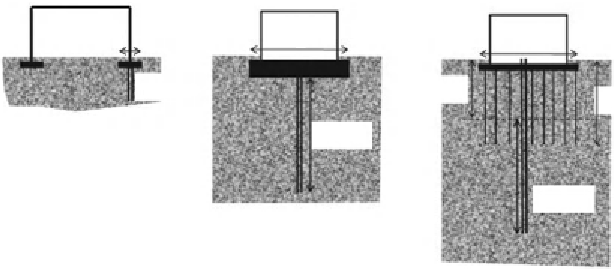Geology Reference
In-Depth Information
Widely spaced pads or strips
Raft foundation
Pile group
B
B
B
B
B
B
> 1.5B
> 1.5B
2/3D
2/3D
D
D
> 1.5B
> 1.5B
> 1.5B
> 1.5B
is or may be complex, ground conditions might need to be proved to greater depth and several
boreholes might be required. Similarly, these criteria do not apply or limit the need to consider
particular site hazards, such as slope stability above or below the site.
remedial works to be implemented, which permitted the project to be
completed on time (Starr et al., 2010). In hindsight, the preliminary
boreholes, which would have been more than adequate for a
normal stretch of road, gave no indication of the degree of dif
culty
and complexity at this unforgiving site, which only became clear
following intensive work involving a wide range of experts. In a
similar manner, the landslide at Pos Selim, Malaysia, described in
Chapter 7,
could not have been anticipated from a few boreholes.
The mechanism was at a very large scale and involved too many
components to have been understood before the major displacements
occurred.
As a general rule, at any site, at least one borehole should be put
down to prove ground conditions to a depth far greater than the depth
of ground to be stressed signi
cantly by the works. Generally, for
foundations, at least one borehole should be taken to at least 1.5
times the breadth (B) of the foundation (
Figure 4.4).
For pile groups,
it is generally assumed that there is an equivalent raft at a depth of 2/3D
where D is the length of piles and the ground should be proved to at
least 1.5B below that level. This is only a general guideline
if there is
any reason to suspect more variable conditions and, where the geology
is non-uniform, one borehole will probably not be enough (
Figure 4.5).
Poulos (2005) discusses the consequences of
-
'
on pile design and performance. Boreholes are often terminated once
rock has been proved to at least 5m, but this may be inadequate to
prove bedrock in weathered terrain (Hencher & McNicholl, 1995).
Whether or not one has reached in situ bedrock might be established
by geological interpretation of consistent rock fabric or structure
across a site, but elsewhere it may be more dif
'
geological imperfections
cult, in which case it








